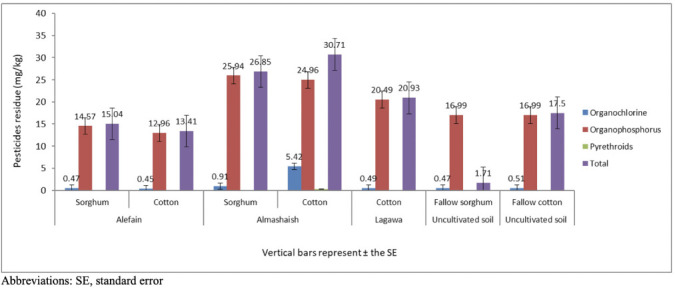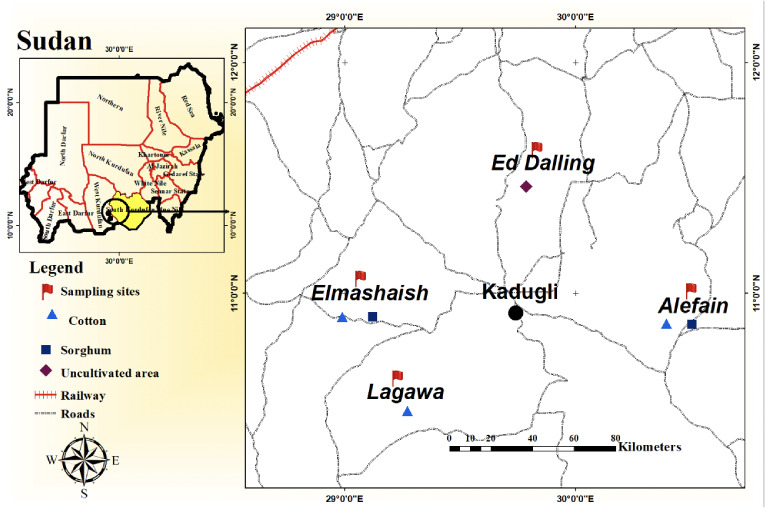苏丹南科尔多凡州努巴山棉公司棉花、高粱和休耕土壤中的杀虫剂残留。
IF 2.4
Q1 Medicine
Journal of Health and Pollution
Pub Date : 2021-06-17
eCollection Date: 2021-06-01
DOI:10.5696/2156-9614-11.30.210608
引用次数: 4
摘要
背景:土壤是包括农药在内的大多数环境污染物的最终储存库。土壤可能因直接施用农药或在喷洒过程中漂移而受到农药污染。农药残留污染的土壤可能影响粮食作物、动物产品和土壤微生物的质量,进而对人类健康和环境产生负面影响。目的:本研究的主要目的是确定苏丹西部南科尔多凡州努巴山棉公司(NMCC)种植的雨养作物中常用农药的土壤残留量。方法:选取阿莱芬(东卡杜格利)、Elmashaish(西卡杜格利)、Ed Dalling荒地(北卡杜格利)和Lagawa(西南卡杜格利)四个地点(代表卡杜格利首府周边的四个方向)进行样本采集。每个地点随机抽取9个土壤样本,分别代表棉花、高粱和有自然植被覆盖的未开垦土地。采用气相色谱(GC) -电子捕获检测器(ECD)和气相色谱-质谱(MS)对土壤样品进行分析。结果:分析结果普遍表明,所有样品中有机磷含量均高于有机氯和拟除虫菊酯,七氯、马拉硫磷和乐果均存在,而对二氯二苯三氯乙烷(DDT)含量均低于检出限。部分样品中检出硫丹α和β异构体。其中乐果含量最高(22.02 mg/kg), β硫丹含量最低(0.015 mg/kg)。总体而言,棉花土壤样品的残留水平高于高粱土壤,平均浓度分别为307.25 mg/kg和58.63 mg/kg。Almashaish的残留量最高,其次是Alefain、Lagawa和Ed Dalling,总残留量分别为57.56 mg/kg、26.34 mg/kg、22.63 mg/kg和17.07 mg/kg。结论:目前的研究揭示了苏丹西部南科尔多凡州雨养棉花计划中一些常用杀虫剂的残留水平。该研究呼吁对该地区的各种环境成分进行定期残留监测,并提出可能的管理措施。利益竞争:作者声明没有经济利益竞争。本文章由计算机程序翻译,如有差异,请以英文原文为准。


Insecticide Residues in Cotton, Sorghum and Fallow Soil from the Nuba Mountains Cotton Corporation of South Kordofan State, Sudan.
Background. Soil is the final depot of most environmental contaminants, including pesticides. Soil may be contaminated by pesticides as a result of direct application or drift during spray activities. Soil contamination with pesticide residues may affect the quality of food crops, animal products, and soil micro-organisms which may in turn negatively affect human health and the environment. Objectives. The main objective of the current study was to determine the soil residues of commonly used pesticides in rain-fed crops grown by the Nuba Mountains Cotton Corporation (NMCC) in South Kordofan state of Western Sudan. Methods. Four locations (representing the four directions around the state capital Kadugli) were chosen for sample collection: Alefain (East Kadugli), Elmashaish (West Kadugli), Ed Dalling uncultivated area (North Kadugli) and Lagawa (Southwest Kadugli). Nine soil samples were randomly taken from each location representing areas under cotton, sorghum, and uncultivated land covered with natural vegetation. Soil samples were analyzed by gas chromatography (GC) equipped with electron capture detector (ECD) and GC-mass spectrometry (MS). Results. The results generally indicated that organophosphate levels were greater than organochlorine and pyrethroids with heptachlor, malathion, and dimethoate present in all samples analyzed, while the level of p,p-dichlorodiphenyltrichloroethane (DDT) was below the detection limit. Endosulfan α and β isomers were detected in some samples. Dimethoate had the highest level (22.02 mg/kg), while β endosulfan was found at the lowest level (0.015 mg/kg). Generally, samples collected from cotton soils showed higher residue levels compared to sorghum soil with average concentrations of 307.25 mg/kg versus 58.63 mg/kg, respectively. Almashaish showed the highest residues levels followed by Alefain, Lagawa, and Ed Dalling with total residues of 57.56 mg/kg, 26.34 mg/kg, 22.63 mg/kg, and 17.07 mg/kg, respectively. Conclusions. The current study sheds light on the residue levels of some of the commonly used pesticides in the cotton rain-fed scheme in South Kordofan State, western Sudan. The study calls for regular residue monitoring in various environmental components in the area and suggests possible management measures. Competing Interests. The authors declare no competing financial interests.
求助全文
通过发布文献求助,成功后即可免费获取论文全文。
去求助
来源期刊

Journal of Health and Pollution
Medicine-Public Health, Environmental and Occupational Health
自引率
0.00%
发文量
0
审稿时长
18 weeks
期刊介绍:
The Journal of Health and Pollution (JH&P) was initiated with funding from the European Union and World Bank and continues to be a Platinum Open Access Journal. There are no publication or viewing charges. That is, there are no charges to readers or authors. Upon peer-review and acceptance, all articles are made available online. The high-ranking editorial board is comprised of active members who participate in JH&P submissions and editorial policies. The Journal of Health and Pollution welcomes manuscripts based on original research as well as findings from re-interpretation and examination of existing data. JH&P focuses on point source pollution, related health impacts, environmental control and remediation technology. JH&P also has an interest in ambient and indoor pollution. Pollutants of particular interest include heavy metals, pesticides, radionuclides, dioxins, polychlorinated biphenyls (PCBs), polycyclic aromatic hydrocarbons (PAHs), volatile organic compounds (VOCs), air particulates (PM10 and PM2.5), and other severe and persistent toxins. JH&P emphasizes work relating directly to low and middle-income countries, however relevant work relating to high-income countries will be considered on a case-by-case basis.
 求助内容:
求助内容: 应助结果提醒方式:
应助结果提醒方式:


